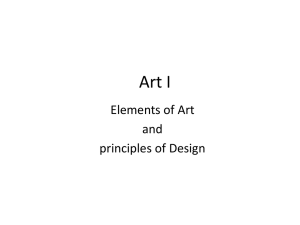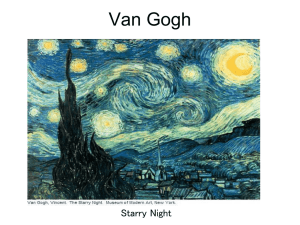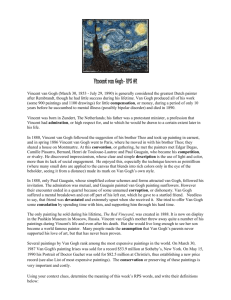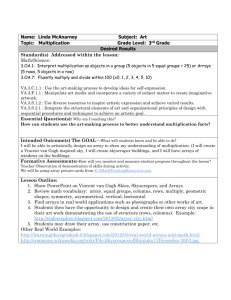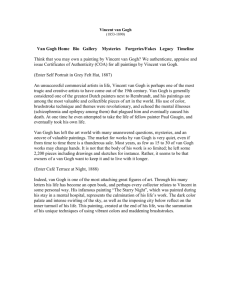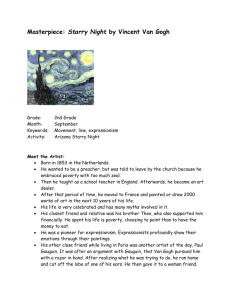Activities in France
advertisement
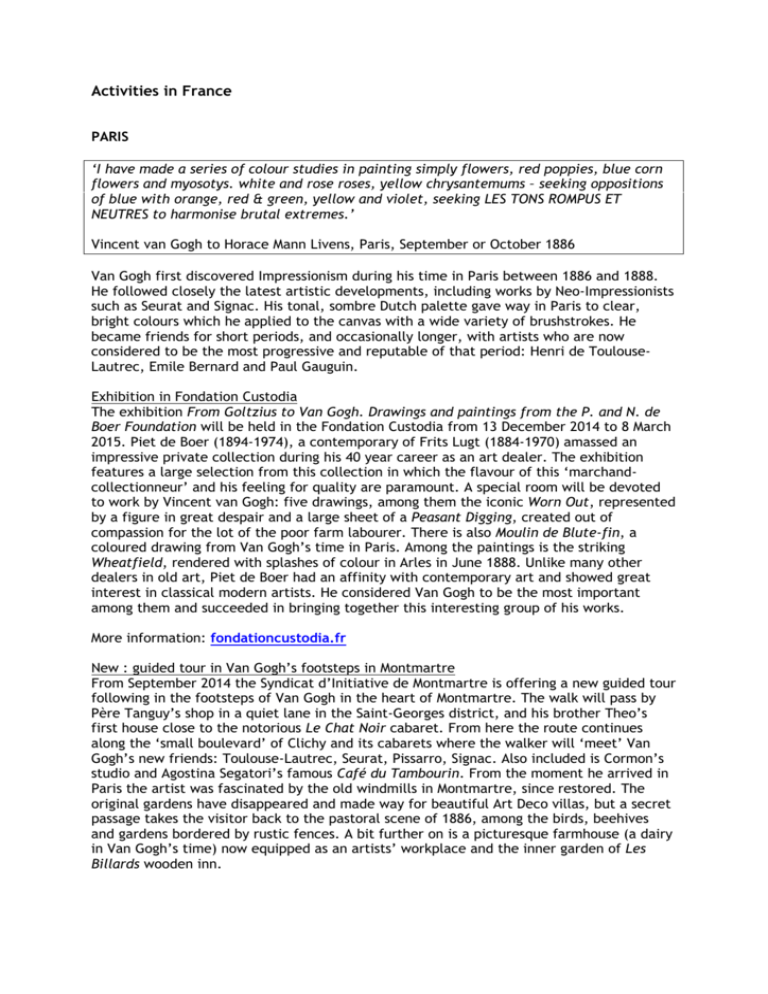
Activities in France PARIS ‘I have made a series of colour studies in painting simply flowers, red poppies, blue corn flowers and myosotys. white and rose roses, yellow chrysantemums – seeking oppositions of blue with orange, red & green, yellow and violet, seeking LES TONS ROMPUS ET NEUTRES to harmonise brutal extremes.’ Vincent van Gogh to Horace Mann Livens, Paris, September or October 1886 Van Gogh first discovered Impressionism during his time in Paris between 1886 and 1888. He followed closely the latest artistic developments, including works by Neo-Impressionists such as Seurat and Signac. His tonal, sombre Dutch palette gave way in Paris to clear, bright colours which he applied to the canvas with a wide variety of brushstrokes. He became friends for short periods, and occasionally longer, with artists who are now considered to be the most progressive and reputable of that period: Henri de ToulouseLautrec, Emile Bernard and Paul Gauguin. Exhibition in Fondation Custodia The exhibition From Goltzius to Van Gogh. Drawings and paintings from the P. and N. de Boer Foundation will be held in the Fondation Custodia from 13 December 2014 to 8 March 2015. Piet de Boer (1894-1974), a contemporary of Frits Lugt (1884-1970) amassed an impressive private collection during his 40 year career as an art dealer. The exhibition features a large selection from this collection in which the flavour of this ‘marchandcollectionneur’ and his feeling for quality are paramount. A special room will be devoted to work by Vincent van Gogh: five drawings, among them the iconic Worn Out, represented by a figure in great despair and a large sheet of a Peasant Digging, created out of compassion for the lot of the poor farm labourer. There is also Moulin de Blute-fin, a coloured drawing from Van Gogh’s time in Paris. Among the paintings is the striking Wheatfield, rendered with splashes of colour in Arles in June 1888. Unlike many other dealers in old art, Piet de Boer had an affinity with contemporary art and showed great interest in classical modern artists. He considered Van Gogh to be the most important among them and succeeded in bringing together this interesting group of his works. More information: fondationcustodia.fr New : guided tour in Van Gogh’s footsteps in Montmartre From September 2014 the Syndicat d’Initiative de Montmartre is offering a new guided tour following in the footsteps of Van Gogh in the heart of Montmartre. The walk will pass by Père Tanguy’s shop in a quiet lane in the Saint-Georges district, and his brother Theo’s first house close to the notorious Le Chat Noir cabaret. From here the route continues along the ‘small boulevard’ of Clichy and its cabarets where the walker will ‘meet’ Van Gogh’s new friends: Toulouse-Lautrec, Seurat, Pissarro, Signac. Also included is Cormon’s studio and Agostina Segatori’s famous Café du Tambourin. From the moment he arrived in Paris the artist was fascinated by the old windmills in Montmartre, since restored. The original gardens have disappeared and made way for beautiful Art Deco villas, but a secret passage takes the visitor back to the pastoral scene of 1886, among the birds, beehives and gardens bordered by rustic fences. A bit further on is a picturesque farmhouse (a dairy in Van Gogh’s time) now equipped as an artists’ workplace and the inner garden of Les Billards wooden inn. More information: montmartre-guide.com Musée d’Orsay: the largest Van Gogh collection outside the Netherlands The Musée d'Orsay is one of the most visited in the world. The museum has its collection of 19th century art to thank for this, in particular its Impressionist masterpieces. Also the unique character of its setting – a former railway station transformed into a ‘palace for the fine arts’- plays a part in that success. The museum displays the work of such great artists as Manet, Gauguin, Monet, Cézanne, Renoir, Gallé and Rodin. They were witness to a period of great creativity, political change, technical discoveries and social unrest. The Musée d'Orsay is home to 24 paintings by Vincent van Gogh, the largest collection outside the Netherlands. The paintings are mainly from his French period and show his artistic development between Paris and Auvers. More information: musee-orsay.fr ARLES ‘Perhaps you’ll be disillusioned with Arles if you come at a time when the mistral’s blowing, but wait... It’s in the long term that the poetry down here soaks in.’ Vincent van Gogh to Paul Gauguin, 17 October 1888 At the beginning of 1888 Van Gogh moved away from congested Paris. He travelled south and on 20 February he arrived in Arles, a small town on the edge of the Camargue where the Rhône splits in two. He stayed there for more than 14 months and during that time he developed into an artist of the sun, and immortalised the Provence landscape in vivid colours. Here in the south he rediscovered the reed pen as a drawing instrument which led to an acclaimed series of pen drawings, often quite impressive in format. The house and studio he rented in Arles (the Yellow House) became the workplace for like-minded artists. Paul Gaugin ended up there, with dramatic results. During their intense collaboration Van Gogh suffered from a nervous disorder and in a fit of insanity he injured himself in the ear. To commemorate the anniversary year the Fondation Vincent van Gogh in Arles which opened in 2014 will be staging an exhibition entitled Van Gogh drawings: influences and innovations. Title Van Gogh drawings: influences and innovations Period From 17 May to 30 August 2015 The exhibition pays attention to the influence of prints and drawings by other artists on Van Gogh’s drawings and minor graphic works. In addition to a selection of about 35-40 drawings and prints by Van Gogh, a series of works will be exhibited which inspired him during his working life. This will include prints from magazines and the 19th century prints which clearly influenced his early work. It will also include replicas of 17th century prints, Japanese prints and other works which had an influence on his remarkable reed pen drawings in Provence. Drawings by contemporary artists will also feature in the exhibition. More information: fondation-vincentvangogh-arles.org SAINT-REMY-DE-PROVENCE ‘…with a sun that floods everything with a light of fine gold.’ Vincent van Gogh to his brother Theo, 5 and 6 September 1889 On 8 May 1889 Vincent van Gogh committed himself to the hospital of van Saint-Paul de Mausole in Saint-Rémy-de-Provence, where he was treated until May 1890. In that year he created numerous drawings and almost 150 paintings, many of which are considered to be masterpieces. The landscape around Saint-Rémy – with the Alpilles mountain range – has remained virtually unchanged since Van Gogh was forced to discover it at the end of the 19th century. It became the backdrop for numerous artists who were inspired by the forms and the unique quality of the light. To commemorate the 125th anniversary of Vincent van Gogh, the partners of Saint-Rémy-de-Provence will present the special encounters between artists and the world that inspired them, and which still inspires them to this day. Title In the very heart of the landscapes painted by Vincent van Gogh in Saint-Rémy-deProvence Period From March to October 2015 List of events 14 March – 7 June 2015 Exhibition in Musée Estrine (Musée de France): All about nature. A century of painting in the Alpilles with works by artists who, like Van Gogh, were inspired by the landscapes of Saint-Rémy-de-Provence: Geizes, Marchand, Prassinos and Bioulès. April 2015 A series of three lectures organised by the Musée Estrine: Vincent van Gogh’s landscapes in Saint-Rémy and in Provence by specialists on the subject of Van Gogh, the 19th century and art from Provence. April – September 2015 Readings from Vincent’s letters to his brother Theo organised by Saint-Rémy-de-Provence in some of the symbolic locations that would have been familiar to Van Gogh. April, September, October 2015 Vincent van Gogh through the eyes of film directors in Ciné-Palace: films and documentaries dedicated to Vincent van Gogh. 19 September – 21 October 2015 Exhibition in the Valetudo gallery: Vincent, from roots to stars and readings from Vincent’s letters to his brother Theo. Spring 2015 Launching of the new digital application and route on location The French Landscapes of Vincent van Gogh. A collaboration between several communities: Communauté de communes Vallée des Baux–Alpilles (CCVBA), community of Auvers-sur-Oise and Vexin National Park (European programme Leader). Permanent Van Gogh Interpretation Centre in the Musée Estrine: about Vincent van Gogh’s contribution to modern and contemporary art. Partners Coordination: Musée Estrine Other partners: Saint-Paul de Mausole Monastery, Valetudo Gallery, commune of SaintRémy-de-Provence, Office de Tourisme, Cinéma Ciné-Palace and Communauté de communes Vallée des Baux–Alpilles (CCVBA) More information: musee-estrine.fr or saintremy-de-provence.com AUVERS-SUR-OISE ‘For really, Auvers gravely beautiful, it’s the heart of the countryside, distinctive and picturesque.’ Vincent van Gogh to his brother Theo, 20 May 1890 Auvers-sur-Oise, just a stone’s throw from Paris, is a favourite destination for lovers of impressionist art. The village owes its fame mainly to Vincent van Gogh. The artist produced almost 80 works here in fewer than 70 days. Some of these painting are among his most famous, such as Wheatfield with Crows, Portrait of Dr.Gachet and The Church at Auvers. Each year Auvers attracts visitors from all around the world on a ‘pilgrimage’ in the footsteps of Van Gogh. This ‘outdoor museum’ has many historical monuments including the church and castle at Auvers which Van Gogh painted, Daubigny’s studio, Dr. Gachet’s house and the Auberge Ravoux where you can visit Van Gogh’s bedroom. This remembrance and meeting place (‘lieu de mémoire - lieu de vie’) was designated a historical monument in 1995 and is the only place where Van Gogh lived which has remained to a large extent in its original condition. Title In the footsteps of Van Gogh Description The 2015 cultural season in Auvers-sur-Oise will have Vincent van Gogh as its theme. It will take the form of an initiative by the community of Auvers-sur-Oise, in collaboration with the Institut Van Gogh and supported by the Paris Ile-de-France Regional Tourist Board. The cultural partners in this artists’ village 30 kilometres northwest of Paris will join forces under the title In the footsteps of Van Gogh. They will offer a rich and varied programme to the approximately 220,000 visitors - often real ‘pilgrims’- who visit the village each year. The first edition took place in 2014; the cultural season will also be repeated in 2016 Period From 4 April to 30 August 2015 List of events - ‘The Van Gogh Experience’ in Auvers-sur-Oise Castle: videos, installations, art in the space where the artist Nowart was inspired by the last 70 days of the life of the artist in Auvers-sur-Oise; - exhibition in Musée Daubigny about the influence of film on art by using the concept of ‘framing’; - open air screening (free entry) of the film Lust for Life by Vincente Minnelli and the making of it; - new digital application Vincent van Gogh’s French Landscapes with which visitors can tread in Vincent van Gogh’s footsteps (see above, under Saint-Rémy-de-Provence: collaboration between several communities). In the footsteps of Van Gogh Partners Cultural partners: Château d’Auvers, Maison du Dr Gachet, Musée Daubigny, Office du Tourisme, Galerie d’Art Contemporain, Eglise Notre Dame d’Auvers and the graveyard where Vincent and Theo van Gogh are buried, Musée de l’Absinthe, Maison-Atelier de Daubigny, Auberge Ravoux, also known as “Maison de Van Gogh”, and the Festival d’Auvers More information: surlespasdevangogh.eu of visitparisregion.com

